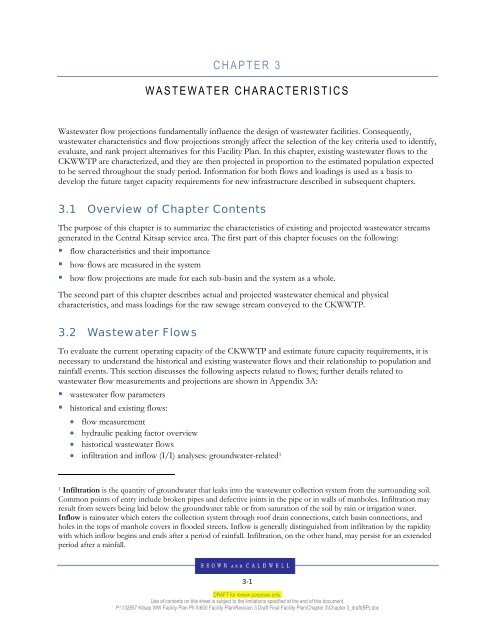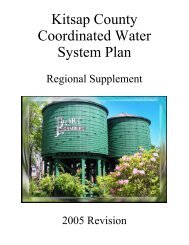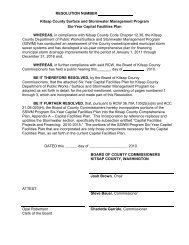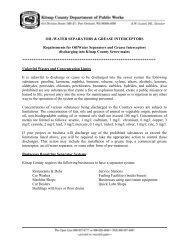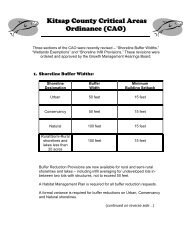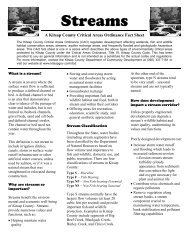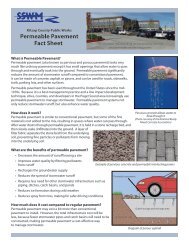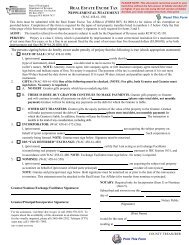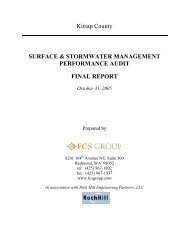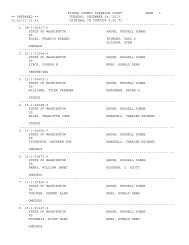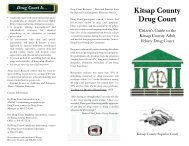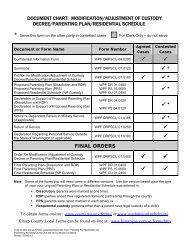CENTRAL KITSAP COUNTY WASTEWATER FACILITY PLAN ...
CENTRAL KITSAP COUNTY WASTEWATER FACILITY PLAN ...
CENTRAL KITSAP COUNTY WASTEWATER FACILITY PLAN ...
You also want an ePaper? Increase the reach of your titles
YUMPU automatically turns print PDFs into web optimized ePapers that Google loves.
CHAPTER 3<br />
<strong>WASTEWATER</strong> CHARACTERISTICS<br />
Wastewater flow projections fundamentally influence the design of wastewater facilities. Consequently,<br />
wastewater characteristics and flow projections strongly affect the selection of the key criteria used to identify,<br />
evaluate, and rank project alternatives for this Facility Plan. In this chapter, existing wastewater flows to the<br />
CKWWTP are characterized, and they are then projected in proportion to the estimated population expected<br />
to be served throughout the study period. Information for both flows and loadings is used as a basis to<br />
develop the future target capacity requirements for new infrastructure described in subsequent chapters.<br />
3.1 Overview of Chapter Contents<br />
The purpose of this chapter is to summarize the characteristics of existing and projected wastewater streams<br />
generated in the Central Kitsap service area. The first part of this chapter focuses on the following:<br />
• flow characteristics and their importance<br />
• how flows are measured in the system<br />
• how flow projections are made for each sub-basin and the system as a whole.<br />
The second part of this chapter describes actual and projected wastewater chemical and physical<br />
characteristics, and mass loadings for the raw sewage stream conveyed to the CKWWTP.<br />
3.2 Wastewater Flows<br />
To evaluate the current operating capacity of the CKWWTP and estimate future capacity requirements, it is<br />
necessary to understand the historical and existing wastewater flows and their relationship to population and<br />
rainfall events. This section discusses the following aspects related to flows; further details related to<br />
wastewater flow measurements and projections are shown in Appendix 3A:<br />
• wastewater flow parameters<br />
• historical and existing flows:<br />
• flow measurement<br />
• hydraulic peaking factor overview<br />
• historical wastewater flows<br />
• infiltration and inflow (I/I) analyses: groundwater-related 1<br />
1 Infiltration is the quantity of groundwater that leaks into the wastewater collection system from the surrounding soil.<br />
Common points of entry include broken pipes and defective joints in the pipe or in walls of manholes. Infiltration may<br />
result from sewers being laid below the groundwater table or from saturation of the soil by rain or irrigation water.<br />
Inflow is rainwater which enters the collection system through roof drain connections, catch basin connections, and<br />
holes in the tops of manhole covers in flooded streets. Inflow is generally distinguished from infiltration by the rapidity<br />
with which inflow begins and ends after a period of rainfall. Infiltration, on the other hand, may persist for an extended<br />
period after a rainfall.<br />
3-1<br />
DRAFT for review purposes only.<br />
Use of contents on this sheet is subject to the limitations specified at the end of this document.<br />
P:\132857 Kitsap WW Facility Plan Ph II\600 Facility Plan\Revision 3 Draft Final Facility Plan\Chapter 3\Chapter 3_draft(BP).doc


